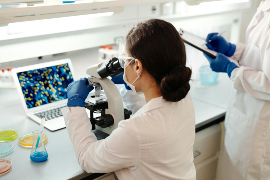Mga spotlight
Biomedical Engineer, Biotechnical Engineer, Biological Systems Engineer, Medical Device Engineer, Bioprocess Engineer
Imagine a world where science and creativity come together to tackle the toughest challenges in agriculture, health, food, and the environment. That’s the realm of bioengineers—modern problem-solvers who blend biology, chemistry, physics, and engineering to invent life-changing technologies. You might find one in a lab late at night, fine-tuning an artificial heart that could one day beat inside a patient, or designing microscopic tools that deliver medicine precisely where it’s needed!
Bioengineers don’t just imagine solutions—they make them real! They develop robotic limbs that move like the human body, grow lab-made tissues to repair injuries, or engineer crops that thrive in harsh conditions and help farmers grow more with less.
Whether working in hospitals, biotech startups, or research labs, bioengineers are building a future where technology and nature work in harmony. Their path is driven by curiosity, creativity, and a deep desire to make the world better through science and design.
- Creating technologies that improve or save lives
- Combining creativity and science to design cutting-edge solutions
- Working on cross-disciplinary teams at the frontier of innovation
- Seeing your designs used in real-world hospitals, farms, or labs
- Contributing to cleaner, healthier, and more sustainable systems
Oras ng trabaho
Work in this field usually takes place in labs, offices, or manufacturing spaces, with a mix of hands-on experiments and computer-based design or analysis. Schedules are typically full-time, but longer hours can come up during product testing, clinical trials, or when solving problems on-site.
Mga Karaniwang Tungkulin
- Design medical devices, prosthetics, or lab equipment
- Develop synthetic tissues, biomaterials, or drug delivery systems
- Optimize bioprocesses for agriculture, pharmaceuticals, or sustainability
- Use software modeling to simulate biological systems
- Collaborate with doctors, scientists, and manufacturers
- Test and troubleshoot prototypes for safety and efficiency
Karagdagang Pananagutan
- Write technical reports and research papers
- Present innovations at conferences or to stakeholders
- Ensure compliance with FDA and other regulatory standards
- Train lab technicians or interns
- Stay current with biotechnology and engineering advancements
A typical day might start with reviewing design specs or lab data. One bioengineer could spend the morning adjusting 3D models of an insulin pump while another calibrates sensors for a wearable health monitor. In the afternoon, they might meet with a physician to discuss patient needs, run tests on a prototype, or input new results into simulation software.
Sometimes their week includes visiting hospitals, farms, or manufacturing plants to test or install new tech.
As one engineer put it, “The coolest part of my job is knowing that something I built in the lab might help a patient walk again—or help produce food with less environmental impact.”
Soft Skills
- Creativity and innovation
- Kritikal na pag-iisip
- Kakayahan sa pakikipag-usap
- Pakikipagtulungan
- Pagtutulungan ng magkakasama
- Kakayahang umangkop
- Detail orientation
- Ethics and responsibility
Teknikal na kasanayan
- CAD and 3D modeling software
- Programming (Python, MATLAB, or R)
- Biomechanics and biomaterials
- Circuit design (for medical electronics)
- Cell and molecular biology
- Simulation and systems modeling
- Regulatory compliance (FDA, ISO)
- Pagsusuri at interpretasyon ng datos
- Biomedical Device Engineers – Create tools like pacemakers or prosthetics.
- Bioprocess Engineers – Improve the efficiency of producing vaccines, enzymes, or fuels.
- Tissue Engineers – Grow synthetic organs or bone scaffolds in the lab.
- Agricultural Bioengineers – Design controlled-environment farms or engineer pest-resistant crops.
- Clinical Engineers – Maintain and improve hospital medical equipment.
- Hospitals and clinical research centers
- Biotech and pharmaceutical companies
- Government agencies (NIH, USDA, DOH)
- Medical device manufacturers
- Environmental and agricultural research labs
- Universities and innovation hubs
- Nonprofits working on global health or sustainability
Bioengineering is a high-stakes field. Your designs may be used in surgery, farming, or manufacturing—so accuracy is critical, and every part must meet safety standards. You’ll often work under tight timelines, and it can take years for a new technology to be approved and used publicly.
But the work is meaningful! Whether you're helping a child walk with a better prosthetic or developing algae that can clean wastewater, the payoff is purpose—and pride in knowing your science makes a difference.
Bioengineering is advancing in exciting ways, from regenerating tissues and organs using stem cells and 3D bioprinting to developing wearable health tech with real-time monitoring. Synthetic biology is being used to create vaccines, sustainable energy, and biodegradable materials. In agriculture, innovations support climate-smart farming and food security. AI is helping improve simulations, diagnostics, and drug design, while global health engineers focus on low-cost medical tools for underserved areas.
Many future bioengineers loved both science and tinkering—taking apart toys, fixing gadgets, or doing science fair projects. Others were fascinated by how the human body works or dreamed of inventing things to help people. If you were the kind of student who liked building robots and studying biology, this is your dream career.
“I had a natural inclination and inquisitive nature about building things. I looked at things and just naturally thought, ‘Okay, how can I make this better?’” - Thomas J. Fogarty, Pioneering Biomedical Inventor
- Bioengineers usually need a bachelor’s degree in bioengineering, biomedical engineering, or a related field such as mechanical, electrical, or chemical engineering with a focus on biological applications
- Employers may expect candidates to have strong backgrounds in biology, chemistry, physics, and advanced mathematics
- Internships or cooperative education (co-op) programs in hospitals, research labs, or biotech companies can be beneficial
- Training in computer-aided design (CAD), laboratory techniques, and data analysis tools is also helpful
- New graduates may receive on-the-job training related to specific products, devices, or regulatory standards
- CPR, lab safety, and infection control procedures are typical requirements in clinical or research settings
Other training may include:
- Good Laboratory Practices (GLP) Certification
- FDA or ISO Regulatory Compliance Training
- Biomedical Device Design Workshops
- Research Ethics and Responsible Conduct of Research (RCR) Certification
- Software training in tools like MATLAB, SolidWorks, or Python for modeling and simulation
- Take advanced science and math classes: focus on biology, chemistry, physics, calculus, and computer science
- Join STEM-related clubs like robotics, science Olympiad, engineering clubs, or coding groups
- Participate in science fairs or research competitions with projects involving healthcare, technology, or sustainability
- Volunteer or intern at hospitals, labs, or engineering firms to gain early exposure to bioengineering environments
- Attend summer camps or pre-college programs in biomedical engineering, biotech, or health sciences
- Learn 3D design, coding, or electronics through online platforms or school electives (e.g., CAD, Python, Arduino)
- Shadow professionals such as biomedical engineers or medical researchers to explore different career paths
- In college, get involved in undergraduate research or apply for lab assistant positions as early as possible
- Choose electives in areas like tissue engineering, biomechanics, or medical imaging to explore your interests
- Build connections with professors and peers—mentors and networks can open doors to internships or grad school
- Take communication or writing courses; explaining your work clearly is key in research and engineering fields
- Join professional student chapters like the Biomedical Engineering Society (BMES) to connect with the field early
- Strong foundation in biology, chemistry, physics, and mathematics (especially calculus and differential equations)
- Opportunities to take electives in biomechanics, biomaterials, medical imaging, or tissue engineering
- Research opportunities with engineering faculty, medical schools, or biotechnology labs
- Internship options with hospitals, medical device companies, pharmaceutical firms, or research institutions
- Access to modern lab and prototyping equipment, such as 3D printers, biosensors, and imaging tools
- Programs with paths to graduate study, PE licensure, or specialized certifications (e.g., medical device design, regulatory affairs)
Kasama sa mga mahuhusay na programa ang:
- Massachusetts Institute of Technology – Department of Biological Engineering
- Johns Hopkins University – Department of Biomedical Engineering
- Georgia Institute of Technology – Wallace H. Coulter Department of Biomedical Engineering
- University of California, San Diego – Department of Bioengineering
- Stanford University – Department of Bioengineering
- Bioengineering Cardiovascular Training Program (BCTP) – University of Washington
- Division of Interdisciplinary Training in Bioengineering – NIH/NIBIB
- Harvard–MIT Program in Health Sciences and Technology (HST)
- Search job boards like BioSpace, EngineeringJobs.net, and BMES Career Center
- Apply for entry-level roles such as biomedical equipment technician, R&D assistant, quality control associate, or regulatory affairs trainee
- Network at university-sponsored job fairs, on LinkedIn, or through professional associations like the Biomedical Engineering Society (BMES)
- Ask professors, lab supervisors, or internship coordinators for recommendation letters or job leads
- Volunteer or intern in hospital engineering departments, medtech companies, or university research labs to gain practical experience
- Tailor your cover letter to highlight your problem-solving ability, lab skills, and passion for improving health through engineering
- Practice mock interviews with a career coach or engineering peer to prepare for technical questions and scenarios involving design, ethics, or safety
- Keep your resume clean and focused! Use bullet points to showcase relevant software (e.g., SolidWorks, MATLAB), design projects, internships, and certifications like FE
- Dress professionally for interviews and go for polished, engineering-appropriate attire that reflects attention to detail and readiness to work in regulated environments
- Start by gaining experience in lab research, product testing, or medical device development
- Pursue certifications like Certified Biomedical Auditor (CBA) or Regulatory Affairs Certification (RAC)
- Consider a master’s or PhD in bioengineering, biomechanics, or a specialized field like neural engineering or tissue engineering
- Get involved in professional organizations such as BMES, IEEE EMBS, or ASME Bioengineering Division
- Take leadership roles in team projects, startup incubators, or academic research labs
- Stay current with advancements in medical technology, FDA regulations, and industry software
- Apply for advanced roles like R&D engineer, clinical trials manager, or senior design engineer
- Eventually move into leadership or strategic roles such as project manager, regulatory affairs director, or chief technology officer—depending on your career path
Mga website
- Biomedical Engineering Society (BMES)
- IEEE Engineering in Medicine and Biology Society (EMBS)
- NIH Office of Intramural Training & Education
- Science Careers – AAAS
- BioSpace
- EngineeringJobs.net
- National Institute of Biomedical Imaging and Bioengineering (NIBIB)
- FDA – Center for Devices and Radiological Health (CDRH)
- MedTech Innovator
- Regulatory Affairs Professionals Society (RAPS)
Mga libro
- The Biotech Primer by BioTech Primer Inc.
- Introduction to Biomedical Engineering by Enderle & Bronzino
- The Body Builders by Adam Piore (narrative stories of bioengineers changing lives)
Not everyone stays on the bioengineering track—some pivot into related fields that offer similar challenges and opportunities to apply technical and scientific skills. These closely related options might be:
- Biomedical Technician
- Mechanical Engineer (Medical Focus)
- Research Scientist (Biotech)
- Inhinyero ng Agrikultura
- Robotics Engineer
- Clinical Trial Coordinator
- Regulatory Affairs Specialist
Newsfeed

Mga Tampok na Trabaho

Mga Online na Kurso at Tool






